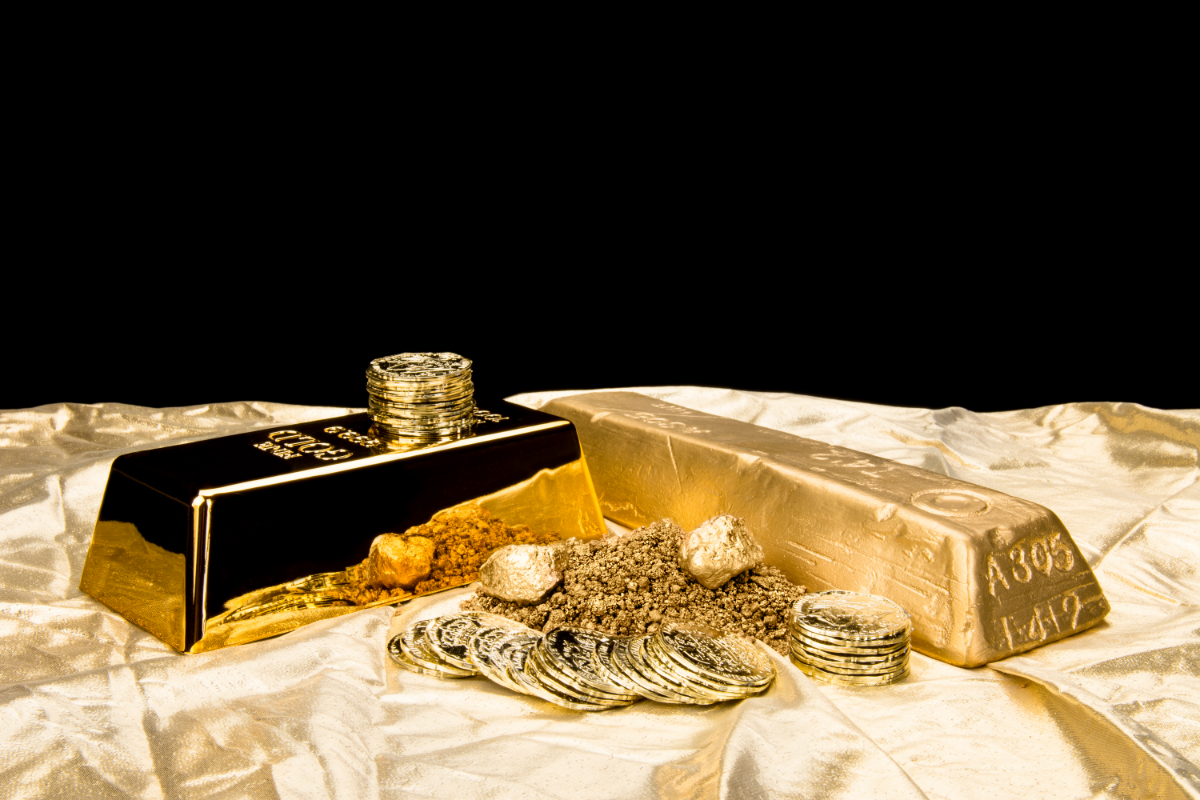If you are interested in investing in precious metals, then you might be contemplating going with either silver, gold, or platinum.

However you may have seen the term gold bullion being exclusively used when describing gold bars, so today we’re going to look at the term gold bullion and define it for you.
We’ll also take a look at how banks will lend and sell bullion, as well as take a closer look at the bullion market and how you can purchase and invest in it.
What Is Bullion?
Bullion refers to silver (see also ‘What Is A Silver Bullion?‘) and gold metal that is at least a 99.5% or 99.9% uree and is found in the form of a bar or ingot. You often see bullion kept behind for use as a reserve by a central Bank or even a government.
This assest can then be borrowed or sold.
Bullion is first discovered by a mining company and then removed from the Earth. This raw form of gold is known as gold ore, and it is a combination of gold and rock that has been mineralized.
This gold is extracted from the ore by use of extreme heat and chemicals. Bullion which contains more than one type of metal is referred to as unparted bullion.
Facts About Bullion
Although bullion is typically used as a way to diversify investments, sometimes it is used as legal tender where it is often held in reserves by central banks.
It’s also used by investors who hedge (see also ‘What Is Hedging In Stocks?‘) it against inflationary effects within their portfolio. Typically around 20% of gold is held by central Banks.
The gold that is held by central banks is used as a reserve which means that the bank will use this to settle any debt or allow it to stimulate the economy through the process of lending gold.
They will lend their golds from their bullion reserve to other bullion Banks at around a rate of 1% which will help them to raise money.
The precious metal market is closely linked with bullion banks (see also ‘What Is Bullion?‘), and some of the activities that they complete include risk management, hedging, trading, vaultiung, but also acting as an intermediary with borrowers.
How Do Banks Lend And Sell Bullion?
As we explained regarding central banks, they can lend their bullion to other banks for a specified period. During this period, it will receive the equivalent in cash of the gold lended to the bank.
Central banks will then lend this money to the market at a lease rate. This is known as the Gold Forward Offered Rates, or GOFO, , which gets published daily.
The higher the lease rate will mean that a central bank has more motivation to lend goals from the reserves. The bank that chooses to borrow goals can either sell this or lend it (see also our article on FPSL stocks) back to mining companies.
The Bullion Market
You can trade bullion in the bullion market. This is an OTC market that is open 24-hours a day, and typically sees trade volume being high as it includes bullying trading prices throughout any given day.
Transactions can be completed electronically or by phone, and there are a number of markets globally which include London, Tokyo, Zurich, and New York.
You can price gold bullion (see also ‘How Can I Cash In Gold Bullion?‘) by demand from any company that uses it to make jewelry and products. You will also see the price of bullion impacted by the overall economy and projections for future perception.
For example, during the time of economic instability, gold became more popular as an investment option.
Both gold and silver bullion (see also ‘How To Sell Gold Bullion‘) are what are known as safe haven investments, which means that they have a price increase during any events such as a war or terrorist activity, or instability that leads to a wider conflict.
Another key factor is inflation or rising prices, and because of these users tend to see the erosion of the return on investment.
For example, if you invest 5% on a bond and overall prices increased by 3%, then your return for that bond is only 2%, whereas prices on commodities also rise at the same time, meaning gold and silver would rise, so they can be used to hedge investment portfolios against an increase in prices or inflation.
What Is Gold Bullion Worth?
Bullion will have a total value of whatever the spot price of gold is at the given time that it is being transacted, as well as how much gold is being transacted.
Gold price will fluctuate every 2 minutes as per changes to the economic and geopolitical spectrum. Gold bullion and its value will change during these periods and never has a fixed price.
For an everyday transaction with gold bullion, a dealer will typically take the current price and then times it by the amount of gold they have to work out the market value.
A higher percentage will typically be offered of the value which will cover costs such as testing and processing the item.
Purchasing And Investing Gold Bullion
There are a number of ways to invest gold bullion. One of the most common ways is to simply purchase it in its physical form, which will be transacted via paper.

They will be purchased from a triple dealer and then kept in a safety deposit box either at home or a bank.
Another method is to go with exchange traded funds (EFTs) which will allow an investor to access the bullion market, in which ETFs contain a collection of securities tracking and underlying index.
Investors can also purchase bullion through the use of future contracts. This is an agreement where you buy or sell assets at a predetermined price and a contract is signed at a specific date in the future.
A soul of gold bullion will commit to delivering gold to a buyer at the expiry date of the contract. Until this delivery happens, legally the buyer will not own the gold.
Final Thoughts
Gold bullion is a popular method for investing and diversifying funds. With many different ways to purchase and invest, this method is not just for the avid investor, all looking to earn a tidy profit.
- How Investment in Crypto Works for Beginners? - December 9, 2025
- Investment in Crypto: The Complete Guide for Beginners and Long-term Investors - December 8, 2025
- Dividend Growth Investing for Millennials - February 27, 2025

